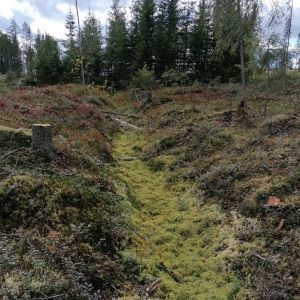Facts:
The project is funded by Formas during 2020–2022.

This project evaluated whether forest ditch cleaning mobilizes a previously stable soil carbon store.
To transition to a fossil-free society, one of the national strategies in Sweden is to improve forest productivity. Higher forest productivity will, in addition to increasing the forest raw material, also mitigate climate change in a cost-effective way by increasing the uptake of carbon sequestration in biomass and soils. One of the strategies to maintain or improve forest productivity is ditch clearing.
The Swedish forest landscape has accumulated carbon since the last ice age about 10,000 years ago. Most of this carbon is 'inactive' and not part of the contemporary carbon cycle. By clearing ditches, there is a risk that this carbon will be released and thus accelerate the greenhouse effect in the atmosphere.
Through studies in the Trollberget experimental catchment area where both felling and ditch cleaning were carried out, the project found that felling increased concentrations and transport of dissolved organic carbon (DOC) while ditch cleaning, on the contrary, had a decreasing effect on DOC in runoff water. However, no changes in carbon age were observed after either felling or ditch cleaning. The results of the project also showed that harvesting had a major effect on the concentration of carbon dioxide in runoff water, where increased light penetration and water temperature led to both higher and more variable carbon dioxide levels.
The short-term results of the study are clear, but the long-term consequences of both felling and ditch clearing need to be studied further to contribute to well-founded decision-making for authorities and forest owners.
The project is funded by Formas during 2020–2022.